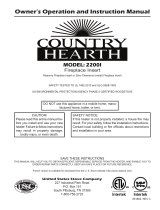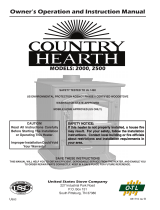
The operation of this unit in a manner inconsistent with the owner’s manual
will void the warranty and is also against federal regulations. United States
Stove Company warrants this product to be free from defects in material and
workmanship, to the original retail purchaser only, for the time period identified
below, measured from the date of the initial purchase as evidenced on an
invoice, cancelled check, sales receipt, etc., to receipt of a claim by United
States Stove Company (“USSC”) or an authorized dealer, as follows:
WARRANTY CONDITIONS
• This warranty only covers USSC appliances that are purchased through an
USSC authorized retailer, dealer or distributor.
• This warranty is only valid while the USSC appliance remains at the site of
original installation. This warranty does not apply to products purchased for
rental use.
CLAIM PROCEDURE
Contact United States Stove Company for warranty service. You will be asked
to provide detailed descriptions and pertinent data, including proof or purchase
which will be returned upon request. Providing the heater has been installed
and used in accordance with the Owner’s Manual supplied with the heater
and the issue does not fall under a situation of exclusion, United States Stove
Company will either:
• Replace the defective part free of charge. Parts and/or service replacements
made under the terms of this warranty are warranted only for the remaining
period of the original heater warranty.
• Replace the heater free of charge. Should the heater be replaced by United
States Stove Company “free of charge”, all further warranty obligations are
thereby met.
• Where the defect is of a cosmetic (non-functional) nature, United States
Stove Company will bear reasonable expense to repair the heater, including
such items as welding, painting, and incidental labor. A “reasonable expense”
is defined by terms of this warranty as $30.00/hour with full refund for any
purchase of parts.
WARRANTY EXCLUSIONS
This warranty does not cover the following:
• Damage to or changes in surface finishes as a result of normal use. As a heating
appliance, some changes in color or interior and exterior surface finishes may
occur. This is not a flaw and is not covered under warranty.
• Damage to printed, plated, or enameled surfaces caused by fingerprints,
accidents, misuse, scratches, melted items, or other external sources and
residues left on the plated surfaces from the use of abrasive cleaners or polishes.
• Repair or replacement of parts that are subject to normal wear and tear during
the warranty period. These parts include: paint, pellet, and the discoloration
of glass.
• Minor expansion, contraction, or movement of certain parts causing noise.
These conditions are normal and complaints related to this noise are not
covered by this warranty.
• Damages resulting from: (1) failure to install, operate, or maintain the appliance
in accordance with the installation instructions, operating instructions, and
listing agent identification label furnished with the appliance; (2) failure to
install the appliance in accordance with local building codes and/or authorities
having jurisdiction; (3) shipping or improper handling; (4) improper operation,
abuse, misuse, continued operation with damaged, corroded or failed
components, accident, alteration, or improperly/incorrectly performed repairs;
(5) environmental conditions, weather, inadequate ventilation, negative
pressure, or drafting caused by tightly sealed constructions, insufficient make-
up air supply, or handling devices such as exhaust fans or forced air furnaces
or other such causes; (6) use of fuels other than those specified in the operating
instructions; (7) installation or use of components not supplied with appliance
or any other components not expressly authorized and approved by USSC; (8)
modification of the appliance not expressly authorized and approved by USSC
in writing; and/or (9) interruptions or fluctuations of electrical power supply
to the appliance.
• Non-USSC venting components, hearth components or other accessories used
in conjunction with the appliance.
• USSC’s obligation under this warranty does not extend to the appliance’s
capability to heat the desired space. Information is provided to assist the
consumer and the dealer in selecting the proper appliance for the application.
Consideration must be given to appliance location and configuration,
environmental conditions, insulation and air tightness of the structure.
• Problems relating to smoking or creosote. Smoking is attributable to inadequate
draft due to the design or installation of the flue system or installation of the
heater itself. Creosote formation is largely attributable to improper operation of
the unit and/or draft as mentioned above.
• Any cost associated with product removal and re-installation, travel,
transportation, or shipping.
• Service calls to diagnose trouble (unless authorized in writing by the
manufacturer, distributor, or dealer).
THIS WARRANTY IS VOID IF
• The appliance has been over-fired or operated in atmospheres contaminated by
chlorine, fluorine, or other damaging chemicals. Over-firing can be identified
by, but not limited to, warped plates or tubes, rust colored cast iron, bubbling,
cracking and discoloration of steel or enamel finishes.
• The appliance is subjected to prolonged periods of dampness or condensation.
• There is any damage to the appliance or other components due to water or
weather damage which is the result of, but not limited to, improper chimney or
venting installation.
LIMITATIONS OF LIABILITY
The owner’s exclusive remedy and USSC’s sole obligation under this warranty,
under any other warranty, express or implied, or in contract, tort or otherwise,
shall be limited to replacement, repair, or refund, in USSC’s sole and absolute
discretion. In no event will USSC be liable for any incidental or consequential
damages. THE LIMITED WARRANTY SET FORTH HEREIN IS THE
SOLE WARRANTY PROVIDED TO PURCHASER AND IS IN LIEU OF
ALL OTHER WARRANTIES AND REPRESENTATIONS, EXPRESS OR
IMPLIED. USSC MAKES NO REPRESENTATIONS OR WARRANTIES
WHATSOEVER, EXPRESS OR IMPLIED, WITH RESPECT TO THE
PRODUCT, OTHER THAN (i) THE LIMITED WARRANTY ABOVE, AND
(ii) ANY IMPLIED WARRANTIES IMPOSED BY APPLICABLE LAW
WHICH CANNOT BE WAIVED OR DISCLAIMED UNDER APPLICABLE
LAW. ALL OTHER WARRANTIES OF ANY KIND, INCLUDING WITHOUT
LIMITATION IMPLIED WARRANTIES OF MERCHANTABILITY AND
FITNESS FOR A PARTICULAR PURPOSE, ARE HEREBY DISCLAIMED
AND EXCLUDED TO THE FULLEST EXTENT NOT PROHIBITED BY
APPLICABLE LAW. This Limited Warranty gives the purchaser specific
legal rights; a purchaser may have other rights depending upon where he or
she resides. Some states do not allow the exclusion or limitation of special,
incidental or consequential damages, or state law may affect the duration of
limitations, so the above exclusion and limitations may not be applicable.
WARRANTOR
The warrantor of record is United States Stove Company, PO Box 151, 227
Industrial Park Road, South Pittsburg, Tennessee 37380. Phone number: (800)-
750-2723. Register your product on line at www.usstove.com. Save your proof
of purchase, as documented in a receipt or invoice, with your records for any
claims.
IMPORTANT
We congratulate you on your selection of United States Stove Company and
its products. As the oldest solid fuel manufacturer in the United States (since
1869), the United States Stove Company is very proud of its products, service,
employees, and satisfied customers. We would like to hear from you if you are
not satisfied with the manner in which you have been handled by our distributor,
dealer, representative, customer service department, parts department, or sales
department. Please reach out to us by using any of the contact information
listed above.
Limited Warranty
852942B
TIME PERIOD
Firebox / Heat Exchanger Limited Lifetime
Door One Year
Cabinets and Trim One Year
Gaskets One Year
All Electrical Components (Blower, Auger
/ Agitator Motor, PC Board, Switches)
One Year
Ceramic Glass One Year
























